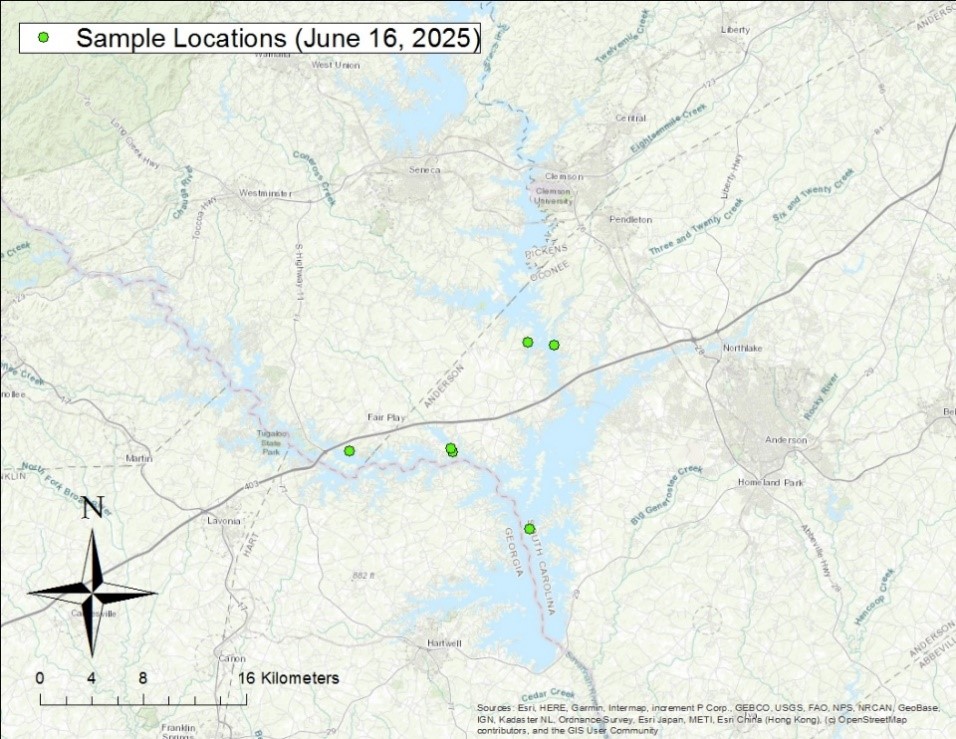SCDES Lifts Recreational Harmful Algal Bloom Watch for Broadway Lake, Provides Update on Lake Hartwell Bloom
FOR IMMEDIATE RELEASE:
June 20, 2025
COLUMBIA, S.C. — The South Carolina Department of Environmental Services (SCDES) continues to monitor the harmful algal blooms (HAB) on Broadway Lake and Lake Hartwell, both near Anderson, S.C. Based on the latest observations and water sample results, the agency has updated its recommendations for protecting public health.
Broadway Lake: Recreational Watch Lifted
Today, SCDES lifted the Recreational Watch for Broadway Lake, which was first issued on June 12.
Samples collected this week indicate a reduced presence of the cyanobacteria (blue-green algae), which initially prompted the Recreational HAB Watch. Additionally, concentrations of the cyanotoxin microcystin in samples collected on June 11 and 17 were below the recreational standards.
Lake Hartwell: Recreational Watch Lifted for Additional Areas
On June 16, SCDES’s Aquatic Science Division (ASD) teams surveyed Lake Hartwell again and collected water samples from six locations, as identified in the map graphic below. SCDES’s Algal Bloom Monitoring Map has been updated with sampling locations and observations.
 Based on the latest data, SCDES has removed certain areas from the Recreational HAB Watch for Lake Hartwell, including:
Based on the latest data, SCDES has removed certain areas from the Recreational HAB Watch for Lake Hartwell, including:
- Six and Twenty Creek lake arm between SC-24 and Centerville Road
- Lower reaches of Lake Hartwell from Sadlers Creek State Park to the Hartwell Dam
- South of Cherry Creek Road to Camp Creek Road, including Martin Creek and Coneross Creek lake arms
The Recreational Watch for Lake Hartwell remains in effect for areas of the Tugaloo and Seneca River lake arms, with the following recommendations:
- avoid direct contact with lake water in areas where the HAB is observed
- keep pets and animals from swimming in or drinking from the lake in areas where the HAB is observed
While the bloom appears to be diminishing in most areas, it’s advised to continue to use caution in areas where the bloom is observed.
The June 16 water samples indicate the ongoing presence of cyanobacteria in certain areas. However, microcystin concentrations in the samples remain below the recreational standard of 8 micrograms per liter.
The HAB may still be found in areas where the Recreational Watch has been lifted. SCDES encourages caution when using or recreating in coves and near the shore.
The most common symptoms associated with HABs are stomach pain, skin rash, headache, coughing and watery eyes. If a pet displays symptoms after coming into contact with a HAB, please consult with your veterinarian.
SCDES will continue to monitor the Lake Hartwell HAB and communicate with local officials, stakeholders and the public. The agency is also in regular communication with the U.S. Army Corps of Engineers.
As a reminder, HABs are a common occurrence in South Carolina lakes. They are typically observed during the warmer and drier months, and they can persist for several weeks. The blooms can look like bright green spilled paint or blue-green discoloration of the water. With cooler temperatures, heavy winds and rain, blooms may begin to break up and die off.
For more information, contact SCDES’s Bureau of Water at 803-898-8374 or by email at HAB@des.sc.gov. If calling after hours, please leave a message that can be returned. For additional information about harmful algae in South Carolina, visit the SCDES HABs webpage and Algal Bloom Monitoring Map.
###

